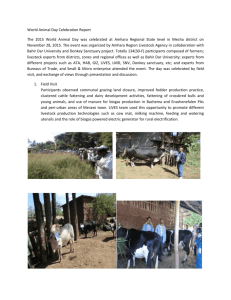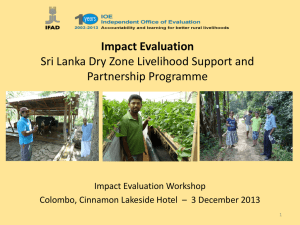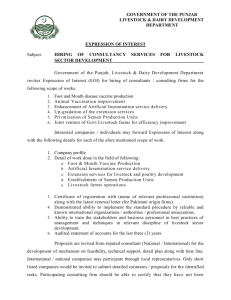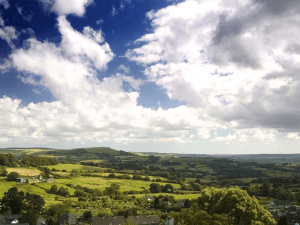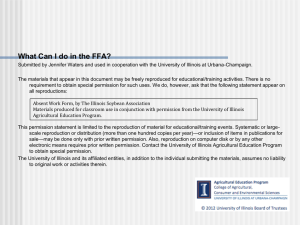Value chain observations report Sidama zone sept - LIVES
advertisement
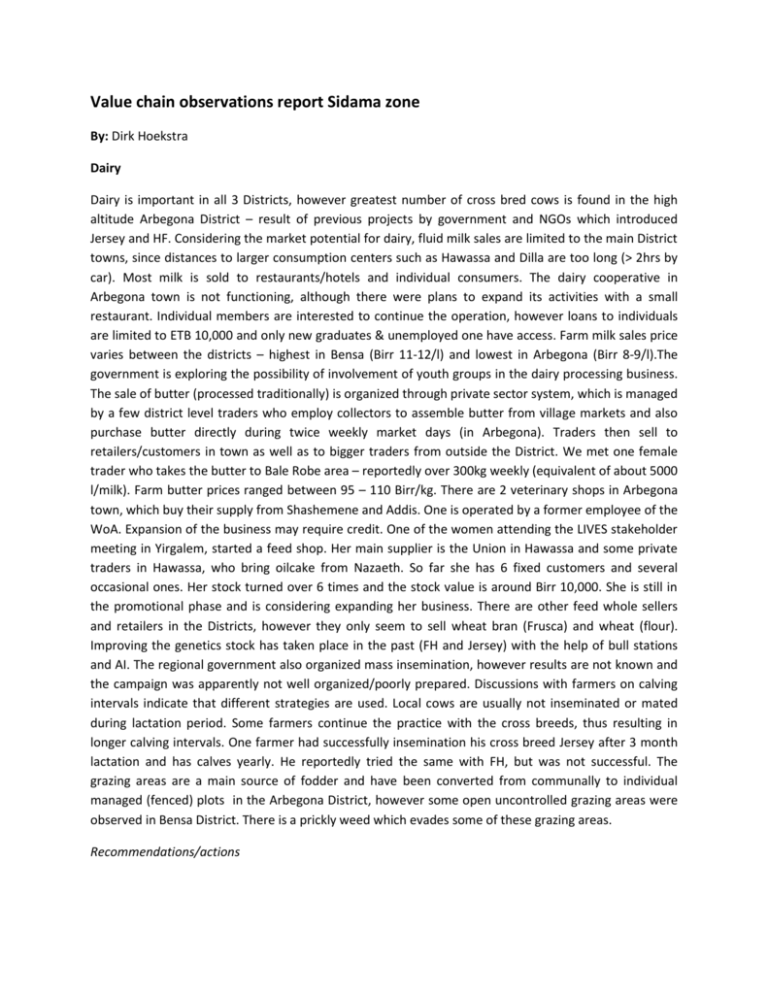
Value chain observations report Sidama zone By: Dirk Hoekstra Dairy Dairy is important in all 3 Districts, however greatest number of cross bred cows is found in the high altitude Arbegona District – result of previous projects by government and NGOs which introduced Jersey and HF. Considering the market potential for dairy, fluid milk sales are limited to the main District towns, since distances to larger consumption centers such as Hawassa and Dilla are too long (> 2hrs by car). Most milk is sold to restaurants/hotels and individual consumers. The dairy cooperative in Arbegona town is not functioning, although there were plans to expand its activities with a small restaurant. Individual members are interested to continue the operation, however loans to individuals are limited to ETB 10,000 and only new graduates & unemployed one have access. Farm milk sales price varies between the districts – highest in Bensa (Birr 11-12/l) and lowest in Arbegona (Birr 8-9/l).The government is exploring the possibility of involvement of youth groups in the dairy processing business. The sale of butter (processed traditionally) is organized through private sector system, which is managed by a few district level traders who employ collectors to assemble butter from village markets and also purchase butter directly during twice weekly market days (in Arbegona). Traders then sell to retailers/customers in town as well as to bigger traders from outside the District. We met one female trader who takes the butter to Bale Robe area – reportedly over 300kg weekly (equivalent of about 5000 l/milk). Farm butter prices ranged between 95 – 110 Birr/kg. There are 2 veterinary shops in Arbegona town, which buy their supply from Shashemene and Addis. One is operated by a former employee of the WoA. Expansion of the business may require credit. One of the women attending the LIVES stakeholder meeting in Yirgalem, started a feed shop. Her main supplier is the Union in Hawassa and some private traders in Hawassa, who bring oilcake from Nazaeth. So far she has 6 fixed customers and several occasional ones. Her stock turned over 6 times and the stock value is around Birr 10,000. She is still in the promotional phase and is considering expanding her business. There are other feed whole sellers and retailers in the Districts, however they only seem to sell wheat bran (Frusca) and wheat (flour). Improving the genetics stock has taken place in the past (FH and Jersey) with the help of bull stations and AI. The regional government also organized mass insemination, however results are not known and the campaign was apparently not well organized/poorly prepared. Discussions with farmers on calving intervals indicate that different strategies are used. Local cows are usually not inseminated or mated during lactation period. Some farmers continue the practice with the cross breeds, thus resulting in longer calving intervals. One farmer had successfully insemination his cross breed Jersey after 3 month lactation and has calves yearly. He reportedly tried the same with FH, but was not successful. The grazing areas are a main source of fodder and have been converted from communally to individual managed (fenced) plots in the Arbegona District, however some open uncontrolled grazing areas were observed in Bensa District. There is a prickly weed which evades some of these grazing areas. Recommendations/actions Schedule a livestock platform meeting (for all livestock commodities) including dairy value chain actors and service providers, ensuring participation by women and credit organizations. In partnership with the government, another mass insemination campaign should be planned and implemented with a specially trained mobile team from Sidama Zone, or from the 3 Districts (to be discussed in the platform meeting). Attention needs to be paid to quality in all aspects, especially the mass mobilization of villagers. If possible some PAs in the butter system should also be targeted. Since the production environment in the Districts is ideal for dairy, but sales of fluid milk is limited, the platform should discuss the possibility of production and sales of dairy heifers Examine the businesses of the identified other value chain actors and service providers with the aim of improving their capacity, create up and down ward linkages and develop viable business plans Management of communal grazing area may be considered in Bensa District (see guidelines), control of prickly weeds should be discussed in the platform. Possibilities for using the butter collection system to villages/markets for use of input distribution (concentrate) should be explored in the livestock platform meeting. Possibilities for involving frusca whole sellers and retailers in Bensa and Bona Zuria District in importing concentrate for dairy animals should be discussed in the platform meeting (like the female trader in Arbegona). Fodder Grasses have been introduced in all 3 districts by previous projects and the Woreda agricultural offices. They include Desho, Napier, Guatamala and phalaris grasses. Multiplication/distribution takes place from Government nurseries in the Districts and selected FTCs. Records are reportedly kept on quantities kept and farmers who have received grasses. Presently, most grasses are meant for use by dairy farmers - no assessment of the marketability of planted harvested grasses was made. The project supports this multiplication activity but also tries to introduce legumes, in particular Alfalfa. Project is recording information on this activity Recommendations/actions Synchronize present distribution of grasses with LIVES PAs targeted for dairy production. Review data collection format for seed multiplication with LIVES HQ (Kahsay). In future assess farmer to farmer distribution of grasses. Small ruminants The small ruminants market is diversified in its products and includes young animals (less than 1.5 yr) for reproduction (female) or fattening (male/female), which are usually sold to farmers in the District. The other category is comprised of animals for consumption which are collected from village markets by brokers for traders in District towns. Traders sell them to restaurants and to larger traders from elsewhere (Hawassa, Shasemene). This category includes the “fattened” animals (managed with additional feed resources). Recently traders from Mojo came to buy small sized animals for the export abattoirs. Supply of inputs includes frusca which is sold by whole sale/retailers in District towns. The lady in Abregona also stocks/sells special formulated fattening mix. Production is mainly traditional with producers producing and selling different types of animals. Some farmers have started fattening their own and/or purchased animals. Recommendations/observations Schedule a livestock platform meeting with small ruminants’ value chain actors and service providers, ensuring participation by women and credit organizations. Examine the businesses of the frusca providers with the aim of improving their capacity, create up and down ward linkages and develop viable business plans including purchase and sale of special fattening mix in their store – to be discussed in livestock platform Discuss possibilities for formation of specialized marketing group to target different markets i.e. breeder group to produce animals for further fattening and/or export market, and fattening groups to fatten animals for the domestic/local market – to be discussed in livestock platform Develop production strategies for each group of specialized producers and provide mentoring and coaching and capacity development accordingly. Discuss possibilities for breed improvement interventions with ILRI/ICARDA. Poultry The poultry market centers around the sale of eggs which are collected from villages through assemblers and bulked by a few traders in the District town – we met a female trader in the Arbegona market who sells into the Hawassa market in crates of 1,000. She travels 2 times per week with 12-15 Boxes (Weekly sales volume from 24,000 to 30,000 Eggs). The second product category is pullets or laying hens which are sold within the District, villages. Cocks and old layers are sold by producers (usually women) in the local markets and traders who bulk them for sale elsewhere (Hawassa). Input supply and service provision for poultry are limited, partly as a result of limited or no use of exotic poultry. One per- urban female farmer in Bensa had attempted to produce eggs from 17 exotic chickens , but failed, partly because of insufficient skills and partly because of theft of the birds by 2 gentlemen, who posed as officials of the OoA during the day and returned in the night to “borrow” the chickens for long. Most chickens are of local breeds and some farmers confirmed that a major source of income was the sale of chickens as pullets (sales prices varied between Birr 40-80). One farmer estimated that annually some 40 eggs hatched, with a survival rate to pullet stage, of about 50%. She indicated that hatchability could be influenced by choosing eggs from certain hens. Mortality after hatching was mainly the result of predators (rodents, birds). Farmer had built a small shelter to protect them in the early stages, but after a few weeks they have to start scavenging. Recommendations/actions Schedule a livestock platform meeting with poultry value chain actors and service providers, ensuring participation by women and credit organizations. Develop a strategy for semi commercial egg production in peri urban areas and for local egg/pullet production in rural areas with the help of credit and coaching and mentoring, especially for entrepreneurial women farmers. Discuss possibilities for introducing mortality reducing interventions for local chickens e.g. locally produced hay box brooders and moveable scavenging boxes (see Dale experience on construction). Discuss possibilities for breed improvement measures with ILRI/EIAR. Fruits and vegetables Irrigated fruits and vegetables are still at its infancy although there is a huge water resource potential in all the three districts. In Arbegona, rain fed leafy vegetables and shallots are predominant. Some are sold/ transported to the Hawassa market through District traders. In Bensa district, there are few households engaged in tomatoes production using irrigation and they sell their produces in the local market. There are more farmers who are interested to engage in irrigated tomatoes production. Apple has been introduced to Arbegona district in the past, but was not very successful. Good experiences are however reported from a neighboring District (Hula district, Hagereselam). In lower lying Bona Zuria and Bensa, irrigated dry season production is greater and attempts are made to introduce improved mangoes and avocado varieties. Supply of irrigation pumps is in the initial stages and organized by the OoA, with credit provided through OMO micro finance – pump supplier (Robin) Wondo Trading & Investment P.L.C is a company in Hawassa. Private pump repair services are available. One private repair shop in Bensa has experience with repair of generators and pumps and charges separately for parts (sometimes purchased by customers) and labor. He usually gets spare parts from Addis – he did not know the Hawassa supplier. Recommendations/actions Schedule irrigated fruit and vegetable platform meeting with value chain actors and service providers, ensuring participation by women and credit organizations. For fruit development, concentrate on establishing private (including females) or group nurseries – support with coaching/mentoring and use available expertise from partner organization and neighboring Districts. A start can be made with growing rootstock. Explore possibility to build capacity of a few key actors in apple production in Chenca – check with Kahsay. Test a number of new varieties for expansion of vegetable areas (garlic for higher areas) and onion and tomatoes for lower areas. Onion seed production may also be tried in lower laying areas of Bensa. Discuss with the pump suppliers and the OoA regarding better operation and repairs services. There is a possibility to conduct intensive trainings for important actors on O & M of pumps. IWMI to examine on farm and watershed management issues by individual farmers and schemes.
